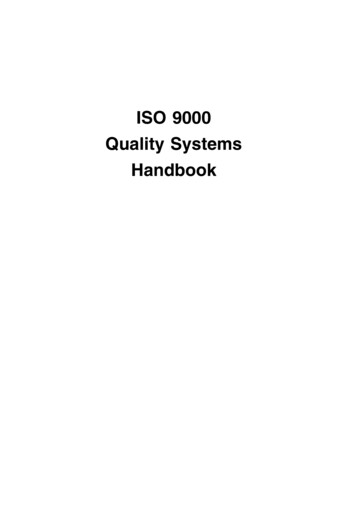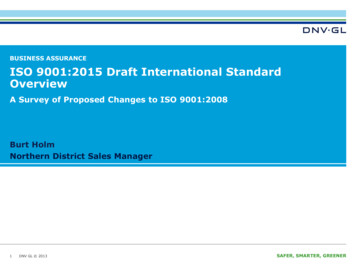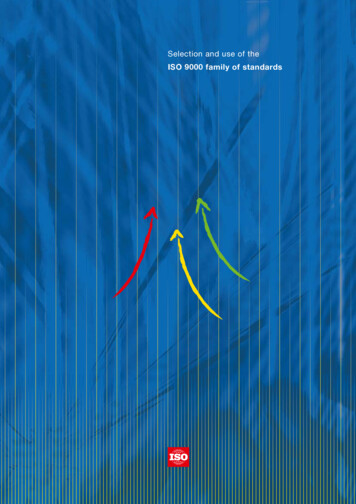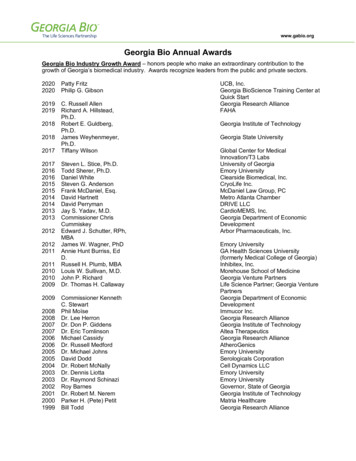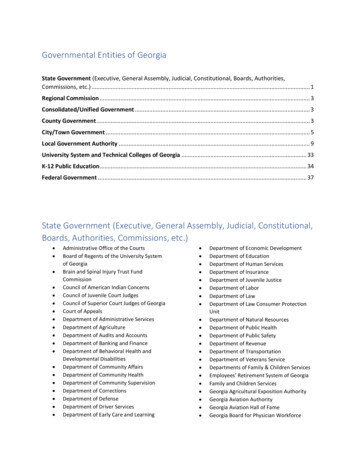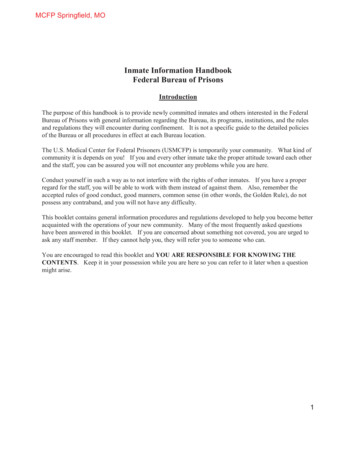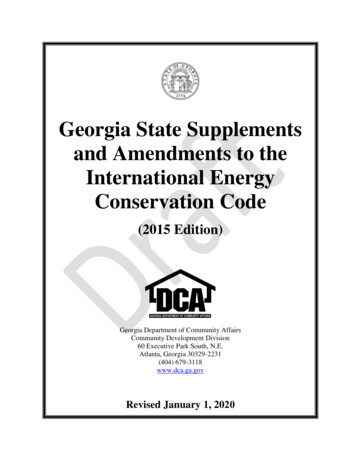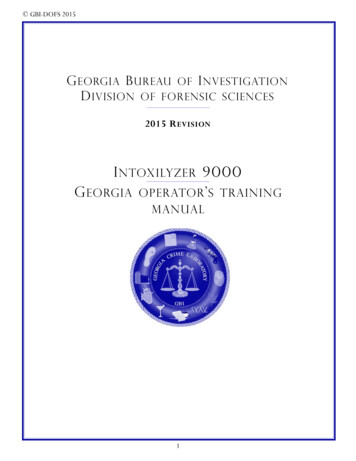
Transcription
GBI-DOFS 2015G EORGIA B UREAU OF I NVESTIGATIOND IVISION OF FORENSIC SCIENCES2015 R EVISIONI NTOXILYZER 9000G EORGIA OPERATOR ’ S TRAININGMANUAL1
INTOXILYZER 9000 GEORGIA OPERATOR’S TRAINING MANUALDISCLAIMERSAll training materials contained herein were developed by theGeorgia bureau of investigationand are delivered in cooperation with theGeorgia state patrol.Logistical training support is provided by TheGeorgia public safety training centerGovernors office of highway safetyAndcriminal justice coordinating councilWhile the administrative, procedural, and clerical steps described in this manual are intended to be used to assist intraining operators in the best practices for breath alcoholtesting, this manual should not be construed as the officialmethod for breath alcohol testing which can be found in GBIRule 92-3Pursuant to O.C.G.A. 40-6-392 the Georgia bureau of investigation promulgates official methods for chemical testing of alcohol in breath. These methods can be found on file at the office of the secretary of state, rules of the Georgia bureau ofinvestigation 92-3.http://rules.sos.state.ga.us/pages/GEORGIA BUREAU OF INVESTIGATION/IMPLIED CONSENT/index.htmlThe information contained in this manual is intended for educational purposes and reference use only, it does not constitute legal advice and neither GBI, GSP, GPSTC, GOHS, CJCC nor theauthor is responsible for the misuse or misrepresentation of information contained herein.The right to reproduce the information contained herein isreserved.2
GBI-DOFS 2015T ABLE OF C ONTENTSIntroduction4-5Foundations of Chemical TestingIntroduction to AlcoholUnderstanding Alcohol in the Human BodyAlcohol Toxicology: Alcohol and the BrainThe Science of Analyzing Alcohol in BreathLegal Foundations for Chemical TestingSummary of Foundational Documents67-1011-1314-1617-2021Intoxilyzer 9000 Operational Principles and PracticesFunctional Overview of the Intoxilyzer 9000The Intoxilyzer 9000 Question SequenceThe Intoxilyzer 9000 Test SequenceThe Intoxilyzer 9000 Breath Test ReportSummary of Breath Test Report FieldsBreath Alcohol LimitationsSummary of Breath Alcohol LimitationsSummary of Common Instrument Display Messages2223-2526-2930-373839-424344Tables and AppendicesAppendix A: GBI Rule 92-3Table 1: Guide to Estimating Alcohol ConcentrationTable 2: Stages of Alcoholic Influence and IntoxicationUseful Links and DocumentsExample 1: Certificate of InspectionAppendix: Recent Court Decisions Affecting DUIDry Gas Ethanol Standard FAQs345-515253545556-6566
INTOXILYZER 9000 GEORGIA OPERATOR’S TRAINING MANUALINTRODUCTIONSince the dawn of the automotive age alcohol consumption has been inextricably linked to public safety. Asearly as 1904, investigators started to notice a growing link between the consumption of alcoholic beverages and motorvehicle involved fatalities. In the ensuing years, scientific research was successful in determining a direct correlationbetween a motorist’s alcohol level and their risk of motor vehicle fatality. This ultimately culminated in the establishment of the first DUI legislation that directly defined permissible alcohol levels in the driving public in 1939. Onceestablished, this legislation created a new challenge for law enforcement officers seeking to enforce it. Due to thefleeting nature of alcohol in the human body, the obtaining of search warrants for the timely collection of specimenbecame a limiting factor in the enforcement of DUI laws. To resolve this problem New York state passed the first Implied Consent law in 1953. This Implied Consent law conditionally granted driving privileges to the motoring public inexchange for implied consent to test their blood, breath, or urine for alcohol if probable cause existed to believe theywere DUI.In order to protect the motoring and boating public Georgia has passed its own DUI and Implied Consent lawsthat can be found in Titles 40 and 52 of the Official Code of Georgia Annotated (O.C.G.A.). Some of the laws directly pertaining to DUI are as follows:O.C.G.A 40-5-55: Georgia’s Implied Consent LawThis law states that any person who operates a motor vehicle on the roads of Georgia and isarrested for the offense of DUI shall be deemed to have given consent to chemical testing. inorder to determine if they are driving under the influence.O.C.G.A 40-5-67.1: Georgia’s Implied Consent Notice.This law defines the warning read to motorists arrested for DUI informing them of the ImpliedConsent Law.O.C.G.A 40-6-391: Georgia’s DUI Statute.This law defines driving under the influence in Georgia.O.C.G.A 40-6-392: Chemical Testing Statute.This law defines the requirements for chemical tests performed in conjunction with the Implied Consent and DUI statute.O.C.G.A 40-1-1: Title 40 Definitions.This statute defines alcohol concentration in terms of blood and breath pursuant to chemicaltesting.Under O.C.G.A. 40-6-392 the legislature has established the methods by which these chemical tests requestedas part of a DUI arrest must be performed. This statute requires that the Georgia Bureau of Investigation: Approve satisfactory techniques and methods to ascertain the qualifications and competence of individualsto conduct analysesIssue permits to conduct analysesIssue requirements for properly operating and maintaining testing instruments.Issue certificates that instruments have met the approval requirements of DOFS.4
GBI-DOFS 2015In conjunction with this authority and obligation, the GBI-DOFS adopted the Rules and Regulations governingImplied Consent - GBI Rules 92-3 (Appendix A). In accordance with this authority, the Director of DOFS has approved breath alcohol testing as an acceptable procedure for alcohol analysis when performed by a certified operator onan approved breath testing instrument.Pursuant to GBI Rule 92-3:(12)(a) The methods approved by the Division of Forensic Sciences for conducting an evidential breath alcoholanalysis shall consist of the following:(1) the analysis shall be conducted on an approved instrument as defined in 92-3-.06 (5).(2) the analysis shall be performed by an individual holding a valid permit, in accordance with Rule92-3-.02 (2); and(3) the testing instrument shall have been checked periodically for calibration and operation, inaccordance with Rule 92-3-.06 (8)(a);In 2012 the GBI made modifications to GBI Rules 92-3 in order to adopt the use of the Intoxilyzer 9000 as an approvedtesting device for evidential breath testing.Pursuant to GBI Rule 92-3-.06:(5) Breath tests other than the original alcohol-screening test shall be conducted on a breath alcohol analyzerapproved by the Director of the Division of Forensic Sciences or his or her designee. Any other type of breathalcohol analyzer not specifically listed in this paragraph must be approved by the Director of the Division ofForensic Sciences or designee prior to its use in the State.(a) The Intoxilyzer Model 5000 manufactured by CMI, Inc. is an approved instrument for breathalcohol tests conducted on or before December 31, 2015;(b) The Intoxilyzer Model 9000 manufactured by CMI, Inc. is an approved instrument for breathalcohol tests conducted on or after January 1, 2013;Thus the state of Georgia is now in the process of transitioning from the use of the Georgia Model Intoxilyzer 5000 tothe Georgia Model Intoxilyzer 9000 as the sole evidential breath testing instrument used throughout the state of Georgia.5
INTOXILYZER 9000 GEORGIA OPERATOR’S TRAINING MANUALFOUDATIONS OF CHEMICAL TESTINGINTRODUCTION TO ALCOHOLThough the term alcohol encompasses an entire class of chemicals that share common structural similarities, itis most often associated with a specific chemical called ethanol or ethyl alcohol that can be found in alcoholic beverages . The common names for ethanol are drinking or grain alcohol. This name is given to ethyl alcohol, becauseunder the right conditions some yeast species can ferment the sugars found in various grains to produce ethyl alcohol.Fermentation of grains, fruits, vegetables, and sugars are the primary sources of alcohol we find in beers, wines, andliquors today. After fermentation this alcohol can be concentrated through a process of evaporating and re-condensingcalled distillation.Sugar YeastFermentationAlcohol HeatBeer 3-6%Wine 7-14%DistillationAlcoholLiquor 40-50%(up to 95%)The strength of an alcoholic beverage is often measured using the proof system. One half of the proof value isthe percentage of alcohol. For example: a 100 proof liquor is 50 % ethyl alcohol ( 100 2 50). The highest proofbeverage likely to be encountered in a DUI situation is 180 proof or 90 % ethyl alcohol and is known by trade namessuch as Everclear or Golden Grain . 200 proof or 100 % ethyl alcohol exists but is very expensive and will not normally be seen outside of a laboratory. As a reference, beers typically contain 3 - 6 % alcohol, wines 7- 14 % alcohol,and liquors 20 - 90 % alcohol. While different types of alcoholic beverages contain different amounts of alcohol, moststandard serving sizes are adjusted to deliver a standard amount of alcohol. The standard drink typically containsabout 0.6 fluid ounces of ethyl alcohol which is roughly equivalent to the amount of alcohol in one regular 12 flozbeer, one 5 floz glass of wine, or 1.5 floz of 80 proof liquor. In addition to ethyl alcohol, most alcoholic beverages contain other compounds called congeners which are largely responsible for the beverage’s distinctive odor. These congeners are also thought to be responsible for many of the “hangover” effects associated with acute alcohol consumption.BeverageAvg. AlcoholContentTypical Content RangeSugar SourceProductionMethodStd ServingsizeBeer3-6%3-14%Barley and HopsFermentation12 floz / 5%Wine10-12%7-14%GrapesFermentation5 floz / 12%Whisky40% / 80 proof40-75%RyeDistillation1.5 floz/ 40%Brandy40% / 80 proof40-43%GrapesDistillation1.5 floz / 40%Vodka40%/ 80 proof40-50%PotatoesDistillation1.5 floz/ oz/40%Tequila40% / 80 proof40-50%AgaveDistillation1.5 floz/ 40%Gin40%40-50%Juniper BerriesDistillation1.5floz / 40%Sometimes products other than alcoholic beverages such as over the counter medications or mouthwashes contain measurable amounts of ethanol for its antiseptic, solvent, or medicinal properties. While it is extremely unlikelythat a person will attain a measurable blood or breath alcohol concentration when using these non-beverage products asthe manufacturer recommends, abuse of these products can lead to alcohol related intoxication.6
GBI-DOFS 2015UNDERSTANDING ALCOHOL IN THE HUMAN BODYWhen discussing the disposition of alcohol in the human body we must be aware that the alcohol concentrationin an individual is dynamic or constantly changing. At any given time the alcohol concentration in a drinking individualis affected by four primary biological processes: administration, absorption, distribution, and elimination. Thus inorder to have a fundamental understanding of the disposition of alcohol in the human body, we must have an understanding of how each of these processes affects alcohol level.AdministrationAs we saw previously, there are numerous sources of alcohol that areavailable for human consumption. It isclear that amount, type, and frequency of alcoholic beverage consumptioncan effect blood or breath alcohol concentration. In addition, the route ofadministration may effect the fractionor the speed of alcohol delivery to thebody. While oral consumption is by farthe most common route of ethyl alcohol administration, alcohol can be administered by other routes such as inhalation or rectal administration.AbsorptionBefore alcohol can affect psychomotor orcognitive function it has to be consumedfrom some alcohol source and be absorbedinto the bloodstream. This process of moving alcohol from the gastrointestinal systemto the circulatory system is termed absorption. The time that it takes for alcohol to becompletely absorbed into the bloodstreamand for a peak alcohol concentration to bereached will vary depending on factors, suchas, type and amount of food consumed withthe alcohol, the quantity and strength of alcohol consumed, and the time interval overwhich consumption occurs. In addition,some physiological factors such as gastricsurgery, disease, and drug use can affect thespeed of absorption.Image adapted from Gray’s Anatomy7
INTOXILYZER 9000 GEORGIA OPERATOR’S TRAINING MANUALTime to Peak BAC vs. Stomach Condition175 lb male - 4 std drinks over 60 minThe factor that generally has the largest effecton the rate of alcohol absorption is the amountand type of food in the stomach. On average aperson consuming alcohol on an empty stomachwill reach a peak alcohol concentration withinapproximately 30 minutes after the end of drinking; however, with a moderate amount of foodpresent in the stomach the peak may be may notbe reached until one hour after the conclusion ofdrinking. When a large amount of food is presentin the stomach, it may take as long as two hoursafter alcohol consumption to reach peak alcoholconcentration. In rare instances times to reachpeak alcohol concentration have been reported inexcess of two hours after the conclusion of drinking; however such cases are uncommon and arelikely the result of disease or physiological abnormality.DistributionIt is well understood that a person’s BAC is directly related to the amount of alcohol they consume, but it is also largely affected by how the alcohol is distributed throughout the body. In reality only a small fraction of the alcohol consumed actually remains in the bloodstream after absorption. The majority of alcohol in the body distributes out of theblood into the water containing tissues and fluids. The movement of alcohol from the blood to the tissues and otherwater containing spaces of the body is known as the distribution of alcohol. The extent to which a person can distribute alcohol out of the bloodstream and intro the tissues will greatly affect the peak blood and breath alcohol concentration they reach. For the most part alcohol will distribute evenly into the total volume of water found within a person’s body. Thus the greater the volume of water in a person’s body, the greater the amount of alcohol that will distribute out of the blood stream and the lower the resulting BAC will be. This being said very few things can cause rapid significant changes in the total amount of water in the body without endangering a person’s health. Because mostlean tissues are more than 70% water, the primary factors affecting the distribution of alcohol in a drinking subject arethe weight of the subject and the body fat percentage of the subject. An average healthy male is about 60% water byweight; however, this may vary slightly in proportion to his body fat percentage because fat is almost completely devoid of water. This means that two people of the same weight who consume the same amount of alcohol may notreach the exact same BAC if the volume of water into which they distribute that alcohol (or volume of distribution)differs. Ultimately the factor that has the largest effect on the distribution of alcohol for a person of a given weight isbody fat percentage because it is highly correlated to the percentage of the body mass that is composed of water. Theaverage body fat percentage for males is about 14-18%, and the average body fat percentage for females is about 2329%. Thus we would expect women on average to exhibit lower volumes of distribution (Vd) than men of the sameweight. The correlation between average body fat percentage, weight, and peak BAC can be seen in the illustrationbelow.Avg male 17% body fat(Vd 0.7L/kg)Avg female 29% body fat(Vd 0.6 L/kg)*This chart does not account for alcohol elimination or unabsorbed alcohol.** Drink is defined as 0.6floz of alcohol equivalent.8
GBI-DOFS 2015EliminationAlmost immediately after the consumption of alcohol, the process of removing alcohol from the body, known asalcohol elimination, begins. This is accomplished through an enzymatic conversion process called metabolism andexcretion of alcohol into fluids or gases leaving the body. Metabolism is the process by which some compounds in thebody are chemically changed so that they are less toxic to the body, more useful to the body, or more easily eliminated.The majority of alcohol that is consumed is eliminated by the liver through metabolism by the enzyme alcohol dehydrogenase (ADH). The ADH enzyme converts ethanol to acetaldehyde, which is ultimately further converted by a series ofother enzymes to carbon dioxide and water. During each pass through the liver, more alcohol is metabolized until thereis no alcohol remaining in the bloodstream. Metabolism in the liver typically accounts for the elimination of 90% to95% of the alcohol consumed. The remaining alcohol is primarily eliminated through excretion into bodily fluids andgases such as urine (2-5%), breath (2-5%), and sweat ( 1%). It has been established that a small amount of alcoholmetabolism takes place in the stomach before it is absorbed into the bloodstream, though the exact magnitude of thismetabolism in the gastric mucosa is still debated. Even if the maximum estimates are assumed, this would only amountto the elimination of about one third of a standard alcoholic beverage from the stomach over a one hour period of time.The rate of elimination tends to be fairly constant for an individual, but will vary within a narrow range for apopulation of subjects. Approximately 95% of the normal population have a rate of elimination that falls within therange of 0.010 to 0.025 grams per 100 ml (or dL) of blood per hour, while the average rate of elimination for thispopulation is about 0.015 grams per dL per hour. Chronic alcohol abusers may exhibit elimination rates as high atwo to three times that of a normal individual due to the development of pharmacodynamics or metabolic tolerance.Chronic alcohol abuse over long periods of time typically results in liver damage and the development of cirrhosis of theliver, which may ultimately adversely affect normal liver function.Elimination RateRangeWhere SeenFrequencyAverage RateOther Notes 0.01 g/dl/hrPeople with abnormal liver functionVery UncommonNANA0.01 – 0.025 g/dL/hrNon- to SocialDrinkers95% of the population0.015 -0.018 g/dL/hrAvg. Rate is frequency dependent 0.025 g/dL/hrHeavy/ Chronic Alcohol AbusersLess than 5% ofthe population0.023 – 0.030 g/dL/hrReported rates ashigh as 0.05 g/dL/hrMany times the average rate of elimination is used to estimate an alcohol level at some time interval prior to a test. Thispractice is known as retrograde extrapolation. There are many additional variables that must be taken into account before this should be undertaken and typically an operator should not consider any alcohol concentration other than thetest result. For example, simple differences in elimination rate or beta within the normal population can cause significant differences in BAC in both the absorptive and elimination phases, even when all other factors are the same. (Seefollowing graph) In addition, the elimination rate becomes non-linear at alcohol concentrations less than 0.02, makingany estimations involving low alcohol concentrations significantly more difficult to perform.9
INTOXILYZER 9000 GEORGIA OPERATOR’S TRAINING MANUALHypothetical Model: 175 lb man consuming 6 std drinks over 2 hr.0.140.120.10.08BA 0.06C0.040.020Time - minEstimates of alcohol level in an individual based on alcohol consumption, weight, volume of distribution,and elimination rate can be made using an equation known as the Widmark formula. While this formulacan provide accurate estimates when utilized by properly trained individuals, the results are only as accurate as the assumptions underlying the calculation. In reality there are many factors related to administration, absorption, distribution, and elimination of alcohol that can significantly add to the complexity ofestimations of BAC. Thus in most cases the best estimate of a person’s alcohol level is a properly executed chemical test performed as close to the time of arrest as possible.Table of Select Factors Affecting Alcohol LevelProcessFactorRelevant FactorsImpactAdministrationAmountStrength of beverageHighSize of beverageHighTime of orption RateHighStomach Condition (empty vs full)HighDiet (type/amount of food consumed)ModerateDiseases/ PathologiesVariesType of beverage consumedLowSpeed of consumptionLowTime Since AdministrationHighBody massHighVolume of DistributionBody fat percentageModerateElimination RateGenetics and drinking frequencyHighTime Since AdministrationHigh10
GBI-DOFS 2015ALCOHOL TOXICOLOGY: ALCOHOL AND THE BRAINThe nervous system is the information superhighway of the human body. The basic building block of the nervous system is a highly specialized cell called the neuron. This cell, which forms large communication networks, transmits nerve impulses throughout the body which control voluntary and involuntary processes. While neurons do notphysically touch one another, they do chemically communicate at specialized junctions called synapses. In order totransmit nerve impulses across the synapse, the terminating neuron releases chemicals called neurotransmitters. Theseneurotransmitters trigger nerve impulses on the other side of the synapse by attaching to specific receptors on the surface of the post synaptic neuron.The NeuronOnce alcohol reaches the brain it diffuses out of the bloodstream across the blood-brain barrier and starts toexert its effects. Consequently, alcohol related intoxication is closely correlated with the alcohol concentration in thearterial blood reaching the brain. Alcohol mediates its intoxicating effects by interfering with numerous neurotransmitters, as well as the membrane structure of the neuron. Thus alcohol slows, inhibits, and depresses the efficient transmission of nerve impulses which we recognize in an individual as intoxication.Alcohol acts as a depressant in all individuals, and if consumed in sufficient quantity will lead to impairment of various physiological and cognitive functions. Impairment is simply a diminished ability to perform a particular task. Impairment due to alcohol consumption is both task specific and dose dependent. Between the limits ofsobriety and lethality, it is logical to conclude that there exists some threshold level at which all individuals, even thosehabituated or highly tolerant to alcohol, will show detectable and measurable impairment in their ability to operate amotor vehicle safely. For the purposes of determining if a person is driving under the influence, impairment refers to those manifestations which cause a person to operate a motor vehicle less safely than they would undernormal conditions.In Georgia, non-commercial drivers 21 years of age or older are by definition or per se under the influence iftheir measured alcohol concentration is 0.08 or higher within three hours of driving from alcohol consumed before thedriving ended; however, the per se alcohol concentration is 0.04 for commercial drivers and 0.02 for drivers under 21years of age. Present day legal levels and inferences of alcohol influence are the result of almost one hundred years ofresearch on the effects of alcohol and driving. This large volume of research on the effects of alcohol can be dividedinto three primary categories:1. Epidemiological studies of alcohol involvement in traffic crashes and fatalities.2. Roadside studies and driving evaluations.3. Controlled laboratory experiments .11
INTOXILYZER 9000 GEORGIA OPERATOR’S TRAINING MANUALAlcohol related impairment can frequently be observed in the physical manifestations that a subject will typically display while under the influence of alcohol. The degree of impairment is largely proportional to the concentration ofthe alcohol in the subject’s blood or breath. Due to this fact, different alcohol levels are typically defined as differentStages of Intoxication.StageBACRangeNear Sobriety al Manifestations Possible Driving Impairment Nearly normal appearance Onset of judgment andattention impairment Compensatorytracking impairment onset Evasive maneuver /emergency brakingimpairment onset Naïve task impairment Euphoria Increased self confidenceImpaired depth perception Increased risk taking Lack of judgment Slowed reactiontime Slowed glare recovery Difficulty maintaining lane and speed.(divided attention) Increased sociability Decreased inhibitions Impairment of Judgment Impaired divided attention Onset of balance impairment. Emotional Instability Loss of critical thinkingand judgmentDifficulty accelerating smoothly Braking errors Incoordination Inertia/ Lack of balanceSignal/ control errors Slurred speech Difficulty steering /curve taking12Other Comments 50% of drivingstudies show impairment at alcohollevels 0.05 or less Drivers under age21 show significantelevation in crashrisk at BACs above0.02. (Peck, 2007) 95% of drivingstudies show impairment by thetime subjects reacha BAC of 0.08. A BAC of 0.08 represents an increasein crash risk of approximately 300%(Grand RapidsStudy, 1964) 0.12-0.16 is theaverage BAC inDUI related fatalities 99% of drivingstudies show impairment at alcohollevels 0.09 or less A BAC of 0.14 represents an increasein crash risk of approximately 2000%(Grand RapidsStudy, 1964)
GBI-DOFS Coma/Death 0.40Typical Manifestations Possible Driving Impairment Disorientation andmental confusion Gross incoordination Slurred Speech Staggering gait Vomiting Apathy / Lack of muscle control Inability to stand orwalk Loss of consciousness ormemory Loss of bladder control Coma / Death Coma/Death Numerous Effects Driving off roadway Driving wrong direction Improper lane usage Numerous Effects Passing out behindthe wheelOther Comments Increase in crashrisk at 0.17 is4,500%, and goesup exponentially.(Grand RapidsStudy, 1964)It should be noted that the degree to which certain impairing effects may be present at a particular alcoholconcentration may vary from person to person based on an individual’s tolerance to alcohol. Tolerance is thebody’s attempt to diminish or adapt to the frequent presence of large doses of alcohol by reducing or compensating for alcohol’s impairing effects. While the body can exhibit some tolerance to alcohol through physiologicalchanges such as increasing the elimination rate or desensitizing the nervous system, the most common form oftolerance to alcohol is a learned or task dependent behavioral tolerance. It is well known that if simple tasksare practiced repetitively while under the influence of alcohol, a tolerance with respect to those tasks can be developed. Thus people who regularly consume large doses of alcohol may show some learned tolerance to manyof alcohol’s impairing effects on simple tasks and may exhibit a relatively normal outward appearance at highalcohol levels. Unfortunately little to no tolerance is observed at significant alcohol levels with relation to manyof the complex cognitive functions required for driving.Tasks where Tolerance is Pronounced atLevels Greater than 0.08Tasks where Tolerance has Little Effect atlevels Greater than 0.08Simple / Well Learned TasksComplex / Naïve TasksWalkingJudgmentTalkingChoice Reaction TimeSimple Motor TasksComplex Divided Attention SkillsSimple Cognitive Tasks13
INTOXILYZER 9000 GEORGIA OPERATOR’S TRAINING MANUALTHE SCIENCE OF ANALYZING ALCOHOL IN BREATHRespiration is the exchange of gases between an organism and its environment. In humans, respiration involvesthe absorption of oxygen from the environment and the elimination of carbon dioxide from the blood stream to supportlife. During respiration air is taken in through the mouth or nose and transported by the trachea or windpipe into thelungs. In the lungs, the trachea branches into smaller air tubes called bronchi which continue to branch and eventuallyterminate in small air sacs called alveoli. These alveoli are surrounded by capillaries and are elastic in nature. It is inthese pulmonary alveoli that blood is able, by diffusion, to release carbon dioxide and absorb oxygen for use throughoutthe body. If alcohol is present in the blood, it too will diffuse across the alveolar membrane into the breath in a fixedproportion to the alveolar blood alcohol concentration and the core body temperature.The chemical principle that best describes the diffusion of gases between the blood and the breath in thepulmonary alveoli is Henry’s Law. It basically asserts that in a closed system the concentration of a material in the gasstate above a liquid will be proportional to its concentration in the liquid state. This law not only applies to experimentscarried out in beakers and test tubes in the laboratory, but also to the human body. Specifically it applies to the exchangeof alcohol between the blood (liquid) and the breath (gas) in the human lung. In the lungs alcohol continually partitionsbetween the blood and breath, and ultimately, if given enough time, the concentration of alcohol in the breath (BrAC)will reach a defined proportion or balance with the concentration of alcohol in the blood (BAC) in accordance with Henry’s Law. This balance is called equilibrium. It is important to remember that at equilibrium the amount or concentration of alcohol in the breath is proportional, but not equal to the blood alcohol concentration. In fact , inperfect equilibrium at 34 degrees Celsius, the average temperature of human breath, the amount of alcohol in blood isapproximately 2100 times higher than the amount of alcohol in the same volume of breath. This relationship betweenthe concentration of alcohol in the blood and the breath can be described by
In order to protect the motoring and boating public Georgia has passed its own DUI and Implied Consent laws that can be found in Titles 40 and 52 of the Official Code of Georgia Annotated (O.C.G.A.). Some of the laws direct-ly pertaining to DUI are as follows: O.C.G.

